





The coastal protection forest plays an important protective function in safeguarding communities and land uses from extreme storms, rising sea levels, shoreline erosion, sand moving and salt water intrusion. Evidence has shown that by restoring coastal ecosystems, the protective functions of these ecosystems can be restored which in turn increases the resilience of coastal communities and ecosystems, while providing diverse additional benefits such as biodiversity conservation. In Hoa Binh village, the degraded proection forest causes the loss of the protective function of the forest and increases the vulnerability of local communities and adjacent land (villages, agricultural land, underground water sources…). Since 2016, the project has supported a pilot model of reforesting coastal sand-dune forests using a mix of species of acacia (wattle), casuarina (whistle pine) and native species (Melaleuca cajuputi, Myrsine linearis, Lithocarpus concentricus, Syzygium corticosum) on 10 ha of degraded land, classified as protection forest. The aim was to restore the costal forest and increase the resilience of coastal ecosystems and communities. The restoration activity has so far planted 5ha of acacia forest, another 5ha of casuarina and inter-planted 100 clusters of native species.
- Existing local people’s basic awareness on the importance of protection forests to their lives in the context of increasing extreme events
- High commitment and ownership of local people and local authorities towards forest protection and rehabilitation
- Enhancing technical knowledge and skills of local people in forest plantation
- Close technical monitoring and and guidance of community forest protection groups
- It takes time to discuss, persuade and raise awareness of local authorities and local communities on rehabilitating native species and mix-planting native species with the standard species (acacia and casuarina) that had been regulated in the forest plantation agenda of the government for coastal forests
- Room needs to be created for local people to raise their voice on how they would like to approach implementation
- High commitment and support from local authorities is needed at all levels for community forest protection groups to operate and carry out their work properly and sustainably
- Selection of good quality seedlings with support of technical experts is one of the key factors
- A maintenance plan as well as monitoring and evaluation is a crucial factor to decide the success of the pilot measures by local communities and authorities